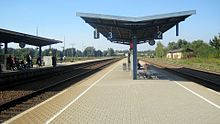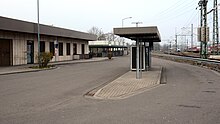
The Rhine-Neckar S-Bahn(S-Bahn RheinNeckar) forms the backbone of the urban rail transport network of the Rhine Neckar Area, including the cities of Mannheim, Heidelberg and Ludwigshafen.

The Mannheim–Saarbrücken railway is a railway in the German states of Baden-Württemberg, Rhineland-Palatinate and the Saarland that runs through Ludwigshafen am Rhein, Neustadt an der Weinstraße, Kaiserslautern, Homburg and St. Ingbert. It is the most important railway line that runs through the Palatinate. It serves both passenger and freight transport and carries international traffic.

The Neustadt–Wissembourg railway, also called the Pfälzische Maximiliansbahn, Maximiliansbahn or just the Maxbahn - is a railway line in southwestern Germany that runs from Neustadt an der Weinstrasse to Wissembourg in Alsace, France. The Palatine Maximilian Railway also included a branch from Winden via Wörth and the Maxaubahn to Karlsruhe.

Neustadt (Weinstr) Hauptbahnhof – called Neustadt a/d. Haardt until 1935 and from 1945 until 1950 – is the central station of in the city of Neustadt in the German state of Rhineland-Palatinate. In addition to the Hauptbahnhof, Rhine-Neckar S-Bahn services stop at Neustadt (Weinstr) Böbig halt (Haltepunkt). Mußbach station and Neustadt (Weinstr) halt, opened on 19 November 2013, are also located in Neustadt.

The Schifferstadt–Wörth railway or Speyer line is a uniformly double track and electrified main line in the German state of Rhineland-Palatinate. Between Schifferstadt and Germersheim it is part of the network of the Rhine-Neckar S-Bahn. Between Germersheim and Wörth am Rhein it is part of the network of the Stadtbahn Karlsruhe.

The Bruhrain Railway is a railway line running from Bruchsal to Germersheim in the German states of Baden-Württemberg and Rhineland-Palatinate. Whilst it was part of a national trunk line (Magistrale) and handled long-distance traffic; today the line is exclusively worked by local trains.

Wiesloch-Walldorf station is in the towns of Wiesloch and Walldorf in the German state of Baden-Württemberg. The station is classified by Deutsche Bahn as a category 3 station. Leimbach Park and the Wiesloch Feldbahn and Industrial Museum are located to the north of the station, with the headquarters of Heidelberger Druckmaschinen and SAP SE on the south-western side.

Schifferstadt station is a separation station in the town of Schifferstadt in the German state of Rhineland-Palatinate, where the Speyer line branches off from the Mannheim–Saarbrücken railway.

Landstuhl station is a station in the town of Landstuhl in the German state of Rhineland-Palatinate. Deutsche Bahn classifies it as belonging to station category 3 and has three platforms tracks. The station is located in the network of the Verkehrsverbund Rhein-Neckar (VRN) and belongs to fare zone 844.

The Winden–Karlsruhe railway is a mainline railway in the German states of Baden-Württemberg and Rhineland-Palatinate, which in its present form has existed since 1938 and is electrified between Wörth and Karlsruhe. The current Winden–Wörth section was opened in 1864. A year later, the gap between the Rhine and the Maxau Railway (Maxaubahn), which had been opened in 1862, was closed. The route of the latter was changed during the relocation of the Karlsruhe Hauptbahnhof. New sections of the line were also built between Wörth and Mühlburg mainly in connection with the commissioning of a fixed bridge over the Rhine.

Wörth (Rhein) station—originally Wörth (Pfalz)—is the most important station of the town of Wörth am Rhein in the German state of Rhineland-Palatinate. Deutsche Bahn classifies it as a category 5 station and it has five platforms. The station is located in the area of the Karlsruher Verkehrsverbund and it belongs to fare zone 540. Since 2001, Verkehrsverbund Rhein-Neckar (VRN) tickets are also accepted for travel to or from the VRN area. The address of the station is Bahnhofstraße 44.

Böhl-Iggelheim station is in the town of Böhl-Iggelheim in the German state of Rhineland-Palatinate. Deutsche Bahn classifies it as a category 5 station and it has two platforms. The station is located in the network of the Verkehrsverbund Rhein-Neckar. Its address is Am Bahnhofsplatz 4.

Limburgerhof station – called Mutterstadt until 1930 – is in the town of Limburgerhof in the German state of Rhineland-Palatinate. Deutsche Bahn classifies it as a category 4 station and it has two platform tracks and two through tracks. The station is located in the network of the Verkehrsverbund Rhein-Neckar and belongs to fare zone 123. Its address is Am Bahnhofsplatz 1.
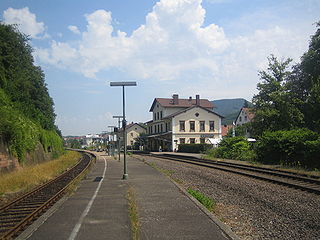
Annweiler am Trifels station is the main station in the town of Annweiler am Trifels in the German state of Rhineland-Palatinate. Deutsche Bahn classifies it as a category 5 station and it has three platform tracks. The station is located in the network of the Verkehrsverbund Rhein-Neckar and belongs to fare zones 181 and 191. Since 2002, Annweiler has also been part of the area served by the Karlsruher Verkehrsverbund using tickets at a transitional rate. Annweiler was always the most important station between Landau (Pfalz) Hbf and Pirmasens Nord and it used to be served by long-distance services.
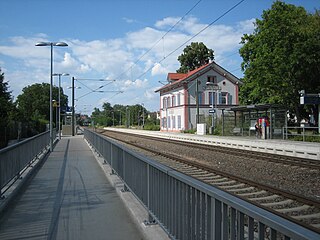
Sondernheim station is a station in the Germersheim suburb of Sondernheim, in the German state of Rhineland-Palatinate. Deutsche Bahn classifies it as a category 6 station and it has two platform tracks. The station is located in the network of the Karlsruher Verkehrsverbund and belongs to fare zone 575. Since 2001, the station has also been part of the area where the fares of the Verkehrsverbund Rhein-Neckar are accepted at a transitional rate. The address of the station is Germersheimer Straße 14. Its former entrance building is under heritage protection.

Bellheim station is a station in the village of Bellheim in the German state of Rhineland-Palatinate. Deutsche Bahn classifies it as a category 6 station and it has two platform tracks. The station is located in the network of the Karlsruher Verkehrsverbund. Since 2001, the station has also been part of the area where the fares of the Verkehrsverbund Rhein-Neckar are accepted at a transitional rate. The address of the station is Bahnhofstraße 8.

Rülzheim station is a station in the town of Rülzheim in the German state of Rhineland-Palatinate. The original station was opened on 25 July 1876 with the commissioning of the Germersheim–Wörth section of Schifferstadt–Wörth railway. The address of the old entrance building, which is heritage listed, is Bahnhofstraße 6.

Rheinzabern station is the main station in the town of Rheinzabern in the German state of Rhineland-Palatinate. Deutsche Bahn classifies it as a category 6 station and it has two platform tracks. It is located on the network of the Karlsruher Verkehrsverbund. Since 2001, the station has also been part of the area where the fares of the Verkehrsverbund Rhein-Neckar are accepted at a transitional rate. Its address is Bahnhofstraße 26.
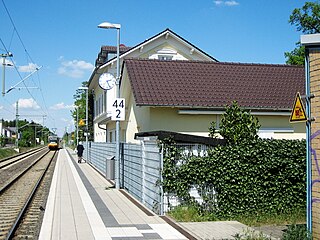
Jockgrim station is the only station in the town of Jockgrim in the German state of Rhineland-Palatinate. Deutsche Bahn classifies it as a category 6 station and it has two platform tracks. It is located on the network of the Karlsruher Verkehrsverbund and belongs to fare zone 555. Since 2001, the station has also been part of the area where the fares of the Verkehrsverbund Rhein-Neckar are accepted at a transitional rate. Its address is Am Bahnhof 1.

The Strasbourg–Wörth railway is a French-German railway, which runs in the French region of Grand Est and the German state of Rhineland-Palatinate.




